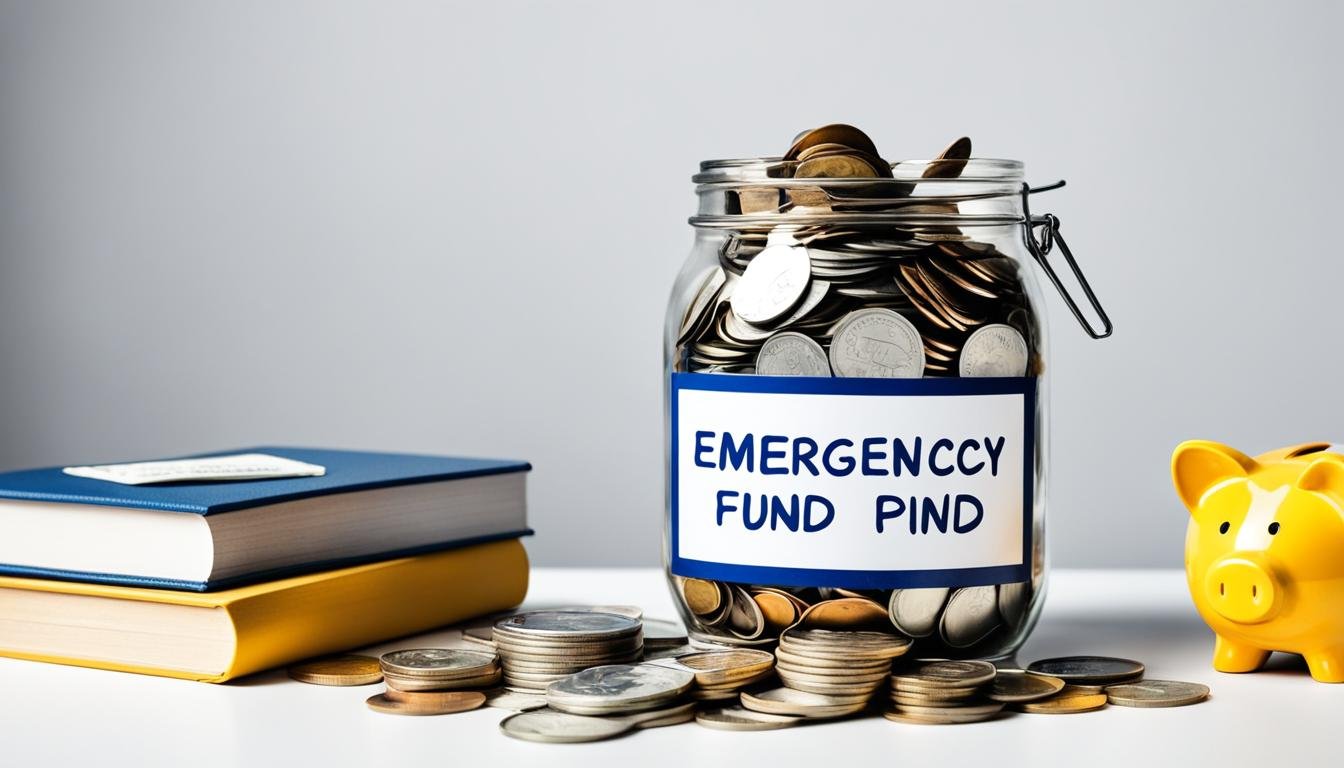Secure Your Future with Emergency Fund Building
An emergency fund is a crucial component of financial stability. It acts as a safety net to protect you from unforeseen expenses or financial emergencies that can disrupt your life. Whether it’s a sudden car repair, a medical bill, or a temporary loss of income, having an emergency fund can provide the peace of mind and financial security you need in these challenging times.
Without an emergency fund, you may find yourself relying on credit cards or loans to handle unexpected expenses, which can lead to debt and financial strain. By taking proactive steps to build an emergency fund, you can safeguard your future and ensure that you have the resources to face any financial storm that comes your way.
Key Takeaways:
- Building an emergency fund is essential for financial stability and peace of mind.
- An emergency fund protects you from unexpected expenses and prevents debt.
- Start by creating a savings habit and managing your cash flow effectively.
- Take advantage of one-time opportunities to save and make saving automatic.
- Choose a safe and accessible place to keep your emergency fund.
The Importance of an Emergency Fund
An emergency fund is essential for your financial wellbeing. It provides a safety net to protect against unexpected expenses and financial shocks. Research shows that individuals with less savings struggle to recover from such shocks and may rely on credit cards or loans, which can lead to debt and long-term financial burden.
Having an emergency fund brings peace of mind. It allows you to face unexpected expenses without the need to tap into other savings, such as retirement funds, or incur high-interest debt. With a reserve fund in place, you can navigate through emergencies without significant financial hardship and maintain stability in your financial life.
The Benefits of an Emergency Fund
- Provides financial security and stability
- Reduces stress and worry about unexpected expenses
- Preserves other savings for long-term goals
- Avoids the need for high-interest debt
- Allows you to handle emergencies without significant financial hardship
Building an emergency fund is a proactive step towards securing your financial future. It ensures that you are prepared for unexpected expenses and can handle financial shocks, providing you with a sense of control and confidence.
“Having an emergency fund is like having your own financial safety net. It’s a crucial component of your overall financial plan.” – Financial Advisor
By establishing an emergency fund, you are safeguarding your financial wellbeing and protecting yourself and your loved ones from future uncertainties.
| Emergency Fund Benefits |
|---|
| Provides financial security and stability |
| Reduces stress and worry about unexpected expenses |
| Preserves other savings for long-term goals |
| Avoids the need for high-interest debt |
| Allows you to handle emergencies without significant financial hardship |
How Much Should You Save?
The amount needed for an emergency fund varies based on individual circumstances. To determine your goal, consider your previous unexpected expenses and their costs. This can help you estimate how much you should have set aside. There is a general rule of thumb to save between three to six months’ worth of living expenses, but this may not be feasible for everyone.
Use an emergency fund calculator to assess your savings goal based on your income, expenses, and financial obligations. Setting aside any amount, even a small one, is beneficial and can provide some level of financial security.
If you’re unsure how to determine the right amount to save for emergencies, an emergency fund calculator can be a useful tool. This online calculator takes into account your income, expenses, and financial obligations to calculate an appropriate savings goal. By inputting this information, you’ll get a clear understanding of how much you need to save to build a sufficient emergency fund.
Tips for Using an Emergency Fund Calculator:
- Gather accurate information about your income, expenses, and financial obligations.
- Use realistic numbers to ensure accurate results based on your current financial situation.
- Consider any additional factors that may affect your emergency fund goal, such as potential job loss or health-related expenses.
- Review and update your calculations periodically to account for any changes in your financial circumstances.
Remember, the most important step is to start saving. Even if you can’t reach the recommended three to six months’ worth of expenses, any amount you can set aside will provide some level of financial security. As you continue to build your emergency fund, you’ll gain peace of mind knowing that you’re prepared for unexpected situations.
Strategies for Building an Emergency Fund
Building an emergency fund requires different strategies depending on your financial situation. By implementing these strategies, you can establish a strong and reliable safety net for unexpected expenses.
Create a Savings Habit
Developing a savings habit is the foundation of building an emergency fund. Make saving a priority by setting aside a specific amount of money regularly. Whether it’s a portion of your paycheck or a fixed amount, consistency is key. By making saving a habit, you’ll ensure a steady growth of your emergency fund over time.
Manage Cash Flow
Effectively managing your cash flow is crucial for saving. Consider adjusting your bill due dates to align with your income cycles, allowing you to have more available money when it’s time to save. Taking advantage of periods with higher cash flow, such as bonuses or tax refunds, can also boost your emergency fund.
Take Advantage of One-Time Opportunities to Save
“Opportunities are usually disguised as hard work, so most people don’t recognize them.” – Ann Landers
Maximize your savings by seizing one-time opportunities. When you receive unexpected cash gifts, bonuses, or tax refunds, allocate a portion of these windfalls directly into your emergency fund. Capitalizing on these opportunities can provide a substantial boost to your savings.
Make Saving Automatic
Automating your savings is an effective way to ensure consistent contributions to your emergency fund. Set up automatic recurring transfers from your checking account to a designated emergency fund account. This hands-off approach eliminates the temptation to spend the money and helps you reach your savings goals faster.
Save through Work
Take advantage of savings opportunities offered through your employer. Many companies provide retirement plans or other programs that allow employees to allocate a portion of their salary directly into an emergency fund. By utilizing these resources, you can automate the saving process and make it more manageable.
By implementing these strategies and staying committed to your goals, you can successfully build an emergency fund to protect yourself from unexpected financial hardships.
Where to Keep Your Emergency Fund
When it comes to your emergency fund, the location is just as important as the amount you save. You want to ensure that your emergency fund is easily accessible in times of need, while also being safe from any temptations to use it for non-emergencies. Here are some options for where you can keep your emergency fund:
1. Bank or Credit Union Account
One of the most common and secure options is to keep your emergency fund in a bank or credit union account. These financial institutions offer various types of savings accounts specifically designed for emergency funds. Putting your emergency fund in a separate account ensures it is not mixed with your everyday spending money, making it easier to track and avoid accidental spending. Plus, it provides easy access to your funds when you need them.
2. Prepaid Card
Another option is to use a prepaid card to store your emergency fund. These cards work by loading a specific amount of money onto the card, which can then be used for purchases. Prepaid cards can be a convenient alternative to a traditional bank account, as they limit your spending to the amount loaded onto the card. This can help prevent any impulsive spending and ensure that your emergency fund remains intact.
3. Cash
Keeping cash on hand is a more tangible option for your emergency fund. You can store your cash in a secure location at home, such as a lockbox or a safe. Alternatively, you can entrust the cash to someone you trust, like a family member or a close friend. However, it’s important to consider the risks associated with keeping cash, such as the potential for loss, theft, or damage. While a cash emergency fund provides immediate access to funds, it may not offer the same level of security as a bank account or prepaid card.
Ultimately, the choice of where to keep your emergency fund depends on your personal preferences and comfort level. The most important factor is to select a location that aligns with your financial goals and ensures the safety and accessibility of your funds.
“A well-allocated emergency fund is like a shield during financial storms.” – Unknown
Tips for Starting an Emergency Fund
Starting an emergency fund can be challenging, but with the right strategies, it becomes achievable. Here are some tips to help you get started:
- Set smaller savings goals: Making the process more manageable and motivating by setting smaller milestones along the way. This will allow you to celebrate your progress and stay motivated.
- Start with small, regular contributions: Building a savings habit without straining your cash flow. Even a small amount saved consistently can add up over time.
- Automate your savings: Take advantage of technology and set up recurring transfers or direct deposits from your paycheck. This ensures consistent contributions to your emergency fund.
- Avoid increasing your monthly spending: Stick to your budget and resist the temptation to splurge on unnecessary items. Opening new credit cards can also lead to unnecessary debt.
- Don’t over-save: While it’s important to prioritize your emergency fund, make sure to find a balance that allows you to enjoy life and work towards other financial goals simultaneously.
By following these tips, you can take the first steps towards building an emergency fund and securing your financial future.
Starting an emergency fund requires commitment and discipline, but it’s an essential part of financial planning. By setting attainable goals, automating your savings, and making wise financial choices, you can start building your emergency fund and gain peace of mind. Remember, it’s never too late to start, and even small contributions add up over time.
Overcoming Obstacles to Building an Emergency Fund
Building an emergency fund is a crucial step toward financial security. However, many individuals face obstacles along the way that can make saving difficult. Common challenges include daily expenses, discretionary spending, and the temptation to neglect saving altogether. Overcoming these obstacles requires a shift in mindset and discipline in managing your finances.
Setting Smaller Savings Goals
One effective strategy for building an emergency fund is to start with smaller savings goals. Instead of trying to save a large sum of money all at once, break it down into achievable milestones. For example, set a target to save $500 or $1,000 initially, and then gradually increase that amount over time. By setting realistic goals, you can make saving more manageable and stay motivated throughout the process.
Starting with Small, Regular Contributions
Consistency is key when it comes to building an emergency fund. Rather than waiting to save a large amount, start with small, regular contributions. Designate a specific amount to save each week or month, and make it a habit. Even a modest contribution can add up over time and provide a solid foundation for your emergency fund.
Automating the Savings Process
To ensure consistent saving, automate the process as much as possible. Set up automatic transfers from your checking account to a separate savings account dedicated to your emergency fund. This way, the money is moved out of sight and out of mind before you have a chance to spend it. Automation makes it easier to stick to your saving goals and reduces the temptation to use the money for non-emergency purposes.
Reviewing and Reducing Expenses
One of the biggest obstacles to building an emergency fund is the presence of unnecessary expenses. Take a close look at your spending habits and identify areas where you can cut back. Consider canceling subscriptions or memberships that you rarely use, reducing dining out expenses, and finding more cost-effective alternatives for everyday items. Redirecting these savings toward your emergency fund can help you accumulate funds more quickly.
Finding Creative Ways to Save
Building an emergency fund doesn’t have to be limited to traditional saving methods. Get creative and find additional ways to save money. Look for discounts or coupons when making purchases, buy items in bulk to take advantage of lower prices, and consider DIY alternatives for certain services or repairs. These small savings can add up over time and contribute to your emergency fund.
As you start making progress with your emergency fund, it’s important to resist the temptation to increase your spending or open new credit cards. Stay focused on your savings goals and remind yourself of the financial security and peace of mind that come with having an emergency fund. By staying disciplined and avoiding unnecessary expenses, you can continue to build your fund effectively.
By implementing these strategies and staying committed to your financial goals, you can overcome the obstacles that may arise when building an emergency fund. Remember that every small contribution counts, and your efforts will pay off in the long run, providing you with the financial stability and security needed to handle unexpected expenses.
Making the Most of Your Emergency Fund
An emergency fund goes beyond providing financial security. It offers a range of benefits that contribute to your overall peace of mind and stability. By building and maintaining an emergency fund, you can navigate unexpected expenses and avoid falling into the trap of high-interest debt or depleting other savings.
- Peace of Mind: Having an emergency fund reduces stress and worry when faced with unexpected expenses. Knowing that you have a financial safety net allows you to handle emergencies with confidence, without the fear of significant financial hardship.
- Protection Against Debt: An emergency fund acts as a buffer, preventing the need to rely on credit cards or loans to cover unexpected expenses. By having the funds readily available, you can avoid accumulating high-interest debt and its long-term financial consequences.
- Preservation of Savings: Your emergency fund serves as a dedicated pool of funds for unexpected events. By utilizing this reserve, you can avoid tapping into other savings, such as retirement accounts or vacation funds. This ensures that your long-term savings goals remain intact.
- Stability in Uncertain Times: Life is full of uncertainties, and having an emergency fund provides stability during challenging periods. Whether faced with a job loss, medical emergency, or natural disaster, having financial resources readily available can help you navigate these difficult times.
Building an emergency fund is a proactive step toward securing your financial well-being. It empowers you to handle unexpected expenses and offers peace of mind. By prioritizing and nurturing your emergency fund, you create a solid foundation for a more secure and resilient financial future.
Example Table:
| Emergency Fund Benefit | Description |
|---|---|
| Peace of Mind | An emergency fund reduces stress and worry about unexpected expenses, providing reassurance and security. |
| Financial Stability | Having an emergency fund protects against significant financial hardship during times of uncertainty or emergencies. |
| Debt Prevention | An emergency fund helps avoid the need for high-interest loans or credit card debt when faced with unexpected expenses. |
| Savings Preservation | By relying on your emergency fund, you can preserve other savings, such as retirement funds or vacation savings. |
Common Mistakes to Avoid When Building an Emergency Fund
Building an emergency fund is an essential step towards financial security and peace of mind. However, it’s important to be aware of common mistakes that can hinder your progress and undermine the effectiveness of your fund. By avoiding these mistakes, you can ensure that your emergency fund grows steadily and serves its purpose when needed.
Neglecting to Prioritize Saving
One of the most common mistakes when building an emergency fund is failing to make saving a priority. It’s easy to get caught up in daily expenses and discretionary spending, but without consistent saving, your emergency fund won’t grow as quickly as you need it to. Make saving a non-negotiable part of your financial routine and allocate a specific portion of your income towards your emergency fund.
Using the Emergency Fund for Non-Emergencies
Another mistake to avoid is dipping into your emergency fund for non-emergency expenses. It’s important to establish clear guidelines for what constitutes a true emergency and stick to them. Using the fund for non-essential purchases or unexpected but non-emergency expenses can deplete your reserves and leave you unprepared for a genuine financial crisis.
Failing to Track Progress
Tracking your progress is crucial when building an emergency fund. Without regular monitoring, it’s easy to lose sight of your savings goals and fall off track. Keep a record of your contributions and watch your fund grow over time. Regularly reviewing your progress can also help you stay motivated and make any necessary adjustments to your savings strategies.
Not Adjusting Savings Strategies as Needed
Financial circumstances can change over time, and it’s essential to adjust your savings strategies accordingly. If your income increases or decreases, you may need to reassess the amount you contribute to your emergency fund. Additionally, life events such as marriage, having children, or purchasing a home may require adjustments to your savings goals. Stay flexible and adapt your savings strategies to suit your evolving needs.
By avoiding these common mistakes, you can build a robust and reliable emergency fund that will provide you with the financial security and stability you need during unexpected times. Remember, building an emergency fund is a long-term commitment, and staying disciplined and focused on your goals will pay off in the end.
Maximizing the Growth of Your Emergency Fund
While building an emergency fund is essential for financial security, it’s also important to consider how you can maximize its growth. By allocating excess funds to investment vehicles that provide higher returns, you can optimize the growth of your emergency fund over time.
One way to do this is by investing in retirement accounts or other long-term investments. These options typically offer higher returns compared to a traditional savings account. By taking advantage of compound interest, your emergency fund can grow steadily over the years and provide an additional layer of financial protection.
It’s crucial, however, to strike a balance between growth and accessibility. While investing can boost your emergency fund’s growth potential, you should also ensure that you have easy access to your funds in case of unexpected expenses or emergencies.
If you’re unsure about investment options or the potential risks involved, it’s recommended to consult with a financial planner or advisor. They can help you assess your risk tolerance, explore suitable investment opportunities, and guide you towards a balanced emergency fund savings plan.
Example: Comparing Savings and Investment Returns
| Savings Account | Investment Portfolio |
|---|---|
| Annual interest rate: 0.5% | Annual return: 7% |
| Initial amount: $10,000 | Initial amount: $10,000 |
| Final amount after 10 years: $10,505 | Final amount after 10 years: $19,671 |
In the example above, we compare the growth of a savings account with a 0.5% annual interest rate to an investment portfolio with a 7% annual return over a 10-year period. As you can see, the investment portfolio significantly outperforms the savings account, resulting in a higher final amount.
While investments come with risks, diversification and a long-term perspective can mitigate those risks and potentially provide greater returns.
In conclusion, while the primary purpose of an emergency fund is to provide financial security, you can also maximize its growth potential. Consider investing your excess funds in options that offer higher returns, such as retirement accounts or other long-term investments. However, always prioritize accessibility and be mindful of potential risks. Consult with a financial professional to find the right balance and make informed decisions for your emergency fund.
Conclusion
Building an emergency fund is an essential step towards securing your financial future. By following key strategies and tips, you can start and grow your emergency fund, ensuring you have a safety net for unexpected expenses and financial shocks.
To begin, create a savings habit by setting specific goals and making saving a regular part of your financial routine. Manage your cash flow by monitoring and adjusting your expenses, allowing you to free up more funds for your emergency fund.
Take advantage of one-time opportunities to save, such as tax refunds or cash gifts, to quickly boost your emergency fund. Make saving automatic by setting up recurring transfers or direct deposit, ensuring consistent contributions without the need for constant manual efforts.
Choose a suitable location for your emergency fund, whether it’s a bank or credit union account, a prepaid card, or even keeping cash on hand. Avoid common mistakes like using your emergency fund for non-emergencies and regularly track your progress towards your savings goals.
Remember, building an emergency fund is a gradual process, so start small but be consistent. With a well-established emergency fund, you can face the future with confidence and peace of mind, knowing that you have the financial security to handle unexpected expenses.







